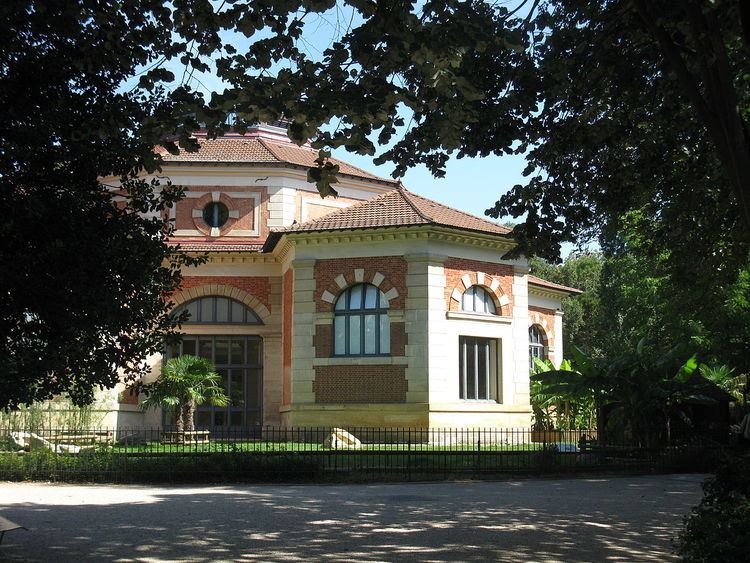Date opened December 11, 1794 Land area 5.5 ha (14 acres) Annual visitors 500,000 Opened 11 December 1794 Phone +33 1 40 79 56 01 | No. of animals 1,000 Memberships EAZA Area 6 ha | |
 | ||
Hours Closing soon · 9AM–5:30PMThursday9AM–5:30PMFriday9AM–5:30PMSaturday9AM–5:30PMSunday9AM–5:30PMMonday9AM–5:30PMTuesday9AM–5:30PMWednesday9AM–5:30PMSuggest an edit Notable animal Jumbo (African bush elephant) Similar Jardin des Plantes, Paris Zoological Park, Grande galerie de l'Évolutio, Jardin d'Acclimatation, National Museum of Natural H Profiles | ||
La m nagerie du jardin des plantes
The Ménagerie du Jardin des Plantes is a zoo in Paris, France, belonging to the botanical garden Jardin des Plantes. It is the second oldest zoological garden in the world (after Tiergarten Schönbrunn). Today it does not have very large animals like elephants, but a lot of rare smaller and medium-sized mammals and a variety of birds and reptiles.
Contents
- La m nagerie du jardin des plantes
- Faune sauvons la m nagerie du jardin des plantes
- The location
- The botanical garden
- The foundation of the menagerie
- Research
- Attractions and species growth
- Literature
- References
Faune sauvons la m nagerie du jardin des plantes
The location
The Zoo is located directly by the Seine in the centre of Paris. It takes up about one third of the Jardin des Plantes.
The botanical garden
In the beginning the term Jardin des Plantes referred only to a botanical garden of 58 acres (230,000 m2), created and built by the royal physicians Jean Herouard and Guy de La Rousse. It therefore became known as the royal herb garden. Created in 1626 and opened for the public in 1635, it is the oldest part of the national research and educational institute for science, the Muséum national d'histoire naturelle, which was founded in 1793.
The foundation of the menagerie
In the course of the French Revolution the menagerie was founded in 1793. According to a decision of the National Assembly in 1793, exotic animals in private hands were to be donated to the Menagerie in Versailles or killed, stuffed and donated to the natural scientists of the Jardin des Plantes. However, the scientists let the animals (the exact number of which is unknown) live. In due course the Royal Menagerie in Versailles (ménagerie royale) was dissolved and these animals were also transferred to the Jardin des Plantes. Jacques-Henri Bernardin de Saint-Pierre (1737–1814) is considered to be the founder of the menagerie. He was committed to the principles of keeping exotic animals in their natural environment, having regard to their needs, placing them under scientific supervision, and allowing public access in the interest of public education.
The Jardin was free for all visitors and tourists right from its inception. While the menagerie at first was just provisional it grew in the first three decades of the 19th century to be the largest exotic animal collection in Europe. The Zoo was under the scientific leadership of the former head of the zoological department at the museum, Étienne Geoffroy Saint-Hilaire (1772–1844). From 1805 onwards the menagerie was under the leadership of Frédéric Cuvier, who was replaced in 1836 by Geoffroy's son Isidore Geoffroy Saint-Hilaire.
Research
The institutional incorporation of the menagerie within the National Research Institute of the National Natural History Museum facilitated the academic study of the animals by doctors and zoologists. Studies related to systematics, morphology and anatomy were all carried out, notably by Georges Cuvier. Étienne Geoffroy, Frédéric Cuvier (the brother of Georges Cuvier) performed research in the area of behavioral observation. Étienne Geoffroy Saint-Hilaire and Frédéric Cuvier published their results in the quarterly work Histoire des Mammifières. It was first published in 1826 and became one of the foundational books concerning the biology of exotic animals. Furthermore, F. Cuvier's plans regarding the breeding of new domestic animal species were formulated.
Attractions and species growth
The expanding range of species was chiefly the result of French travelling researchers, colonial officials and donations from private people, which accounts for the fact that the animals in the Jardine were not limited to local French species.
The so-called Rotonde was added to the basic enclosures in 1804, and from 1808 was used to harbour large animals such as elephants. In 1805 the bear ditch followed and in 1821, a so-called Fauverie or predator enclosure. The Volieren enclosure (voleries, birdhouses) for diurnal birds of prey was added in 1825, and two years later a birdhouse specifically for pheasants. A monkey house was set up for the first time in 1837, while reptiles had to wait until 1870 for their enclosure. Most animals were kept in functional, classicist, gallery-like buildings. These buildings and the zoo itself can be seen as an expression of the Imperial Power of France.
In another part was the Vallée Suisse which had been built as a romantic garden. Here were several small enclosures which held exotic animals such as antelopes. Some buildings from this period still exist today - the semicircular birdhouse for pheasants (1827), the reptile house and the new pheasants enclosure (1881). At the beginning of the 20th century a hibernation enclosure (1905), a small monkey house (1928), a vivarium (1929), another monkey house (1934) and a reptile house (1932) had been built. A half century passed after this improvement without any further innovations except the restoration of the bear pit and some technical corrections.
A new enclosure for diurnal birds of prey was built in 1983. A variety of renovations were carried out in the 1980s. At the beginning of the 21st century the pheasants enclosure from 1881 was renovated. However, as all of the structures are listed buildings, it is almost impossible to create new structures here. However the Jardin des Plantes still exists today and is the second oldest civil zoo in the world.
